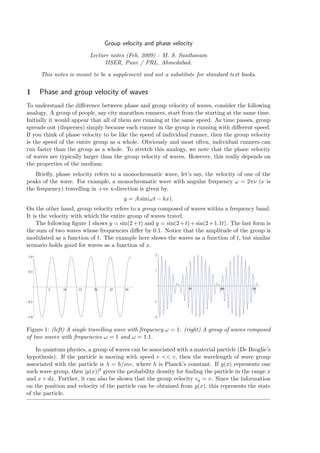
Group and phase velocity
- 1. Group velocity and phase velocity Lecture notes (Feb, 2009) : M. S. Santhanam IISER, Pune / PRL, Ahmedabad. This notes is meant to be a supplement and not a substitute for standard text books. 1 Phase and group velocity of waves To understand the difference between phase and group velocity of waves, consider the following analogy. A group of people, say city marathon runners, start from the starting at the same time. Initially it would appear that all of them are running at the same speed. As time passes, group spreads out (disperses) simply because each runner in the group is running with different speed. If you think of phase velocity to be like the speed of individual runner, then the group velocity is the speed of the entire group as a whole. Obviously and most often, individual runners can run faster than the group as a whole. To stretch this analogy, we note that the phase velocity of waves are typically larger than the group velocity of waves. However, this really depends on the properties of the medium. Briefly, phase velocity refers to a monochromatic wave, let’s say, the velocity of one of the peaks of the wave. For example, a monochromatic wave with angular frequency ω = 2πν (ν is the frequency) travelling in +ve x-direction is given by, y = A sin(ωt − kx). On the other hand, group velocity refers to a group composed of waves within a frequency band. It is the velocity with which the entire group of waves travel. The following figure 1 shows y = sin(2 + t) and y = sin(2 + t) + sin(2 + 1.1t). The last form is the sum of two waves whose frequencies differ by 0.1. Notice that the amplitude of the group is modulated as a function of t. The example here shows the waves as a function of t, but similar scenario holds good for waves as a function of x. 2 1.0 0.5 1 5 10 15 20 25 30 50 100 150 0.5 1 1.0 2 Figure 1: (left) A single travelling wave with frequency ω = 1. (right) A group of waves composed of two waves with frequencies ω = 1 and ω = 1.1. In quantum physics, a group of waves can be associated with a material particle (De Broglie’s hypothesis). If the particle is moving with speed v << c, then the wavelength of wave group associated with the particle is λ = h/mv, where h is Planck’s constant. If y(x) represents one such wave group, then |y(x)|2 gives the probability density for finding the particle in the range x and x + dx. Further, it can also be shown that the group velocity vg = v. Since the information on the position and velocity of the particle can be obtained from y(x), this represents the state of the particle.
